Mullite-like SmMn2O5-Derived Composite Oxide-Supported Ni-Based Catalysts for Hydrogen Production by Auto-Thermal Reforming of Acetic Acid
Abstract
1. Introduction
2. Experimental
2.1. Catalyst Preparation
2.2. Catalytic Performance Test
2.3. Catalyst Characterizations
3. Results and Discussion
3.1. Characterization of Catalyst Oxides
3.2. Characterization of Reduced Catalysts
3.3. Catalytic Performance of the xNSM Catalyst
3.3.1. Reactivity in ATR of HAc
3.3.2. The Turnover Frequency and Apparent Activation Energy
3.3.3. Catalytic Performance of Catalysts on O2/HAc and Different Temperatures
3.4. Characterizations of Spent Catalysts
3.5. Discussion
4. Conclusions
Author Contributions
Funding
Institutional Review Board Statement
Informed Consent Statement
Data Availability Statement
Conflicts of Interest
References
- Ren, J.; Liu, Y.-L. Promoting syngas production from steam reforming of toluene using a highly stable Ni/(Mg, Al)Ox catalyst. Appl. Catal. B Environ. 2022, 300, 120743. [Google Scholar] [CrossRef]
- Xiao, Z.; Li, Y.; Hou, F.; Wu, C.; Pan, L.; Zou, J.; Wang, L.; Zhang, X.; Liu, G.; Li, G. Engineering oxygen vacancies and nickel dispersion on CeO2 by Pr doping for highly stable ethanol steam reforming. Appl. Catal. B Environ. 2019, 258, 117940. [Google Scholar] [CrossRef]
- Kumar, A.; Singh, R.; Sinha, A.S.K. Catalyst modification strategies to enhance the catalyst activity and stability during steam reforming of acetic acid for hydrogen production. Int. J. Hydrogen Energy 2019, 44, 12983–13010. [Google Scholar] [CrossRef]
- Kapdan, I.K.; Kargi, F. Bio-hydrogen production from waste materials. Enzym. Microb. Technol. 2006, 38, 569–582. [Google Scholar] [CrossRef]
- Palanisamy, A.; Soundarrajan, N.; Ramasamy, G. Analysis on production of bioethanol for hydrogen generation. Environ. Sci. Pollut. Res. Int. 2021, 28, 63690–63705. [Google Scholar] [CrossRef]
- Parthasarathy, P.; Narayanan, K.S. Hydrogen production from steam gasification of biomass: Influence of process parameters on hydrogen yield—A review. Renew. Energy 2014, 66, 570–579. [Google Scholar] [CrossRef]
- Winter, C.-J. Hydrogen energy—Abundant, efficient, clean: A debate over the energy-system-of-change. Int. J. Hydrogen Energy 2009, 34, S1–S52. [Google Scholar] [CrossRef]
- Atilhan, S.; Park, S.; El-Halwagi, M.M.; Atilhan, M.; Moore, M.; Nielsen, R.B. Green hydrogen as an alternative fuel for the shipping industry. Curr. Opin. Chem. Eng. 2021, 31, 100668. [Google Scholar] [CrossRef]
- Challiwala, M.S.; Ghouri, M.M.; Linke, P.; El-Halwagi, M.M.; Elbashir, N.O. A combined thermo-kinetic analysis of various methane reforming technologies: Comparison with dry reforming. J. CO2 Util. 2017, 17, 99–111. [Google Scholar] [CrossRef]
- Santamaria, L.; Lopez, G.; Fernandez, E.; Cortazar, M.; Arregi, A.; Olazar, M.; Bilbao, J. Progress on Catalyst Development for the Steam Reforming of Biomass and Waste Plastics Pyrolysis Volatiles: A Review. Energy Fuels 2021, 35, 17051–17084. [Google Scholar] [CrossRef]
- Ren, J.; Cao, J.-P.; Yang, F.-L.; Liu, Y.-L.; Tang, W.; Zhao, X.-Y. Understandings of Catalyst Deactivation and Regeneration during Biomass Tar Reforming: A Crucial Review. ACS Sustain. Chem. Eng. 2021, 9, 17186–17206. [Google Scholar] [CrossRef]
- Thanigaivel, S.; Vickram, S.; Manikandan, S.; Deena, S.R.; Subbaiya, R.; Karmegam, N.; Govarthanan, M.; Kim, W. Sustainability and carbon neutralization trends in microalgae bioenergy production from wastewater treatment: A review. Bioresour. Technol. 2022, 364, 128057. [Google Scholar] [CrossRef] [PubMed]
- Zhao, B.; Hu, Y.; Gao, J.; Zhao, G.; Ray, M.B.; Xu, C.C. Recent Advances in Hydroliquefaction of Biomass for Bio-oil Production Using In Situ Hydrogen Donors. Ind. Eng. Chem. Res. 2020, 59, 16987–17007. [Google Scholar] [CrossRef]
- Zhang, L.; Hu, X.; Hu, K.; Hu, C.; Zhang, Z.; Liu, Q.; Hu, S.; Xiang, J.; Wang, Y.; Zhang, S. Progress in the reforming of bio-oil derived carboxylic acids for hydrogen generation. J. Power Sources 2018, 403, 137–156. [Google Scholar] [CrossRef]
- Vagia, E.; Lemonidou, A. Thermodynamic analysis of hydrogen production via autothermal steam reforming of selected components of aqueous bio-oil fraction. Int. J. Hydrogen Energy 2008, 33, 2489–2500. [Google Scholar] [CrossRef]
- Nabgan, W.; Tuan Abdullah, T.A.; Mat, R.; Nabgan, B.; Gambo, Y.; Ibrahim, M.; Ahmad, A.; Jalil, A.A.; Triwahyono, S.; Saeh, I. Renewable hydrogen production from bio-oil derivative via catalytic steam reforming: An overview. Renew. Sustain. Energy Rev. 2017, 79, 347–357. [Google Scholar] [CrossRef]
- Li, X.; Xue, L.; Zhu, Y.; Chen, G.; Yang, G.; Wang, S. Mechanistic study of bio-oil catalytic steam reforming for hydrogen production: Acetic acid decomposition. Int. J. Hydrogen Energy 2018, 43, 13212–13224. [Google Scholar] [CrossRef]
- Chen, Y.; Zhai, Z.; Liu, J.; Zhang, J.; Geng, Z.; Lyu, H. Exploring the reaction mechanism of ethanol synthesis from acetic acid over a Ni2In(100) surface. Phys. Chem. Chem. Phys. 2020, 22, 7564–7576. [Google Scholar] [CrossRef] [PubMed]
- Jampaiah, D.; Ippolito, S.J.; Sabri, Y.M.; Tardio, J.; Selvakannan, P.R.; Nafady, A.; Reddy, B.M.; Bhargava, S.K. Ceria–zirconia modified MnOx catalysts for gaseous elemental mercury oxidation and adsorption. Catal. Sci. Technol. 2016, 6, 1792–1803. [Google Scholar] [CrossRef]
- Lin, X.; Li, S.; He, H.; Wu, Z.; Wu, J.; Chen, L.; Ye, D.; Fu, M. Evolution of oxygen vacancies in MnOx-CeO2 mixed oxides for soot oxidation. Appl. Catal. B Environ. 2018, 223, 91–102. [Google Scholar] [CrossRef]
- Lee, G.; Kim, D.; Kwak, B.S.; Kang, M. Hydrogen rich production by ethanol steam reforming reaction over Mn/Co10Si90MCM-48 catalysts. Catal. Today 2014, 232, 139–150. [Google Scholar] [CrossRef]
- Wang, Y.; Li, L.; Cui, C.; Da Costa, P.; Hu, C. The effect of adsorbed oxygen species on carbon-resistance of Ni-Zr catalyst modified by Al and Mn for dry reforming of methane. Catal. Today 2022, 384–386, 257–264. [Google Scholar] [CrossRef]
- An, S.; Zhang, Y.; Hu, X.; Xie, X.; Wang, Q.; Chen, H.; Huang, L. Durable Mn(II)Cr(III)Ox composites-supported Ni-based catalysts with wide dynamic range for hydrogen production via auto-thermal reforming of acetic acid. Fuel 2020, 278, 118227. [Google Scholar] [CrossRef]
- Song, Y.; Chen, B.; Hu, X.; Wang, Q.; Xie, X.; Dai, H.; Huang, L. Highly Efficient Al-Doped Ni-Mn-O Catalysts for Auto-Thermal Reforming of Acetic Acid: Role of MnAl2O4 for Stability of Ni Species. Energy Fuels 2020, 34, 14647–14655. [Google Scholar] [CrossRef]
- Mo, S.; Zhang, Q.; Li, J.; Sun, Y.; Ren, Q.; Zou, S.; Zhang, Q.; Lu, J.; Fu, M.; Mo, D.; et al. Highly efficient mesoporous MnO2 catalysts for the total toluene oxidation: Oxygen-Vacancy defect engineering and involved intermediates using in situ DRIFTS. Appl. Catal. B Environ. 2020, 264, 118464. [Google Scholar] [CrossRef]
- Deng, H.; Kang, S.; Ma, J.; Wang, L.; Zhang, C.; He, H. Role of Structural Defects in MnOx Promoted by Ag Doping in the Catalytic Combustion of Volatile Organic Compounds and Ambient Decomposition of O3. Environ. Sci. Technol. 2019, 53, 10871–10879. [Google Scholar] [CrossRef] [PubMed]
- Shi, C.; Zhang, P. Effect of a second metal (Y, K, Ca, Mn or Cu) addition on the carbon dioxide reforming of methane over nanostructured palladium catalysts. Appl. Catal. B Environ. 2012, 115–116, 190–200. [Google Scholar] [CrossRef]
- Zhang, W.D.; Liu, B.S.; Tian, Y.L. CO2 reforming of methane over Ni/Sm2O3-CaO catalyst prepared by a sol–gel technique. Catal. Commun. 2007, 8, 661–667. [Google Scholar] [CrossRef]
- Duarte, R.B.; Nachtegaal, M.; Bueno, J.M.C.; van Bokhoven, J.A. Understanding the effect of Sm2O3 and CeO2 promoters on the structure and activity of Rh/Al2O3 catalysts in methane steam reforming. J. Catal. 2012, 296, 86–98. [Google Scholar] [CrossRef]
- Zheng, Y.; Thampy, S.; Ashburn, N.; Dillon, S.; Wang, L.; Jangjou, Y.; Tan, K.; Kong, F.; Nie, Y.; Kim, M.J.; et al. Stable and Active Oxidation Catalysis by Cooperative Lattice Oxygen Redox on SmMn2O5 Mullite Surface. J. Am. Chem. Soc. 2019, 141, 10722–10728. [Google Scholar] [CrossRef]
- Li, Z.; Hu, X.; Zhang, L.; Liu, S.; Lu, G. Steam reforming of acetic acid over Ni/ZrO2 catalysts: Effects of nickel loading and particle size on product distribution and coke formation. Appl. Catal. A Gen. 2012, 417–418, 281–289. [Google Scholar] [CrossRef]
- Chen, Q.; Liao, F.; Ding, C.; Hu, X.; Xu, Y.; Cheng, P.; Zheng, Z.; Huang, L.; Wang, N. Reaction induced Ni/MgTi2O5 interface promotes the resistance to sintering and oxidation in auto-thermal reforming of acetic acid. Catal. Today 2024, 432, 114635. [Google Scholar] [CrossRef]
- Cychosz, K.A.; Guillet-Nicolas, R.; Garcia-Martinez, J.; Thommes, M. Recent advances in the textural characterization of hierarchically structured nanoporous materials. Chem. Soc. Rev. 2017, 46, 389–414. [Google Scholar] [CrossRef]
- Xu, L.; Zhang, J.; Ding, J.; Liu, T.; Shi, G.; Li, X.; Dang, W.; Cheng, Y.; Guo, R. Pore Structure and Fractal Characteristics of Different Shale Lithofacies in the Dalong Formation in the Western Area of the Lower Yangtze Platform. Minerals 2020, 10, 72. [Google Scholar] [CrossRef]
- Tavanarad, M.; Meshkani, F.; Rezaei, M. Production of syngas via glycerol dry reforming on Ni catalysts supported on mesoporous nanocrystalline Al2O3. J. CO2 Util. 2018, 24, 298–305. [Google Scholar] [CrossRef]
- Lang, Y.; Zhang, J.; Feng, Z.; Liu, X.; Zhu, Y.; Zeng, T.; Zhao, Y.; Chen, R.; Shan, B. CO oxidation over MOx (M = Mn, Fe, Co, Ni, Cu) supported on SmMn2O5 composite catalysts. Catal. Sci. Technol. 2018, 8, 5490–5497. [Google Scholar] [CrossRef]
- Liu, H.; Hadjltaief, H.B.; Benzina, M.; Gálvez, M.E.; Da Costa, P. Natural clay based nickel catalysts for dry reforming of methane: On the effect of support promotion (La, Al, Mn). Int. J. Hydrogen Energy 2019, 44, 246–255. [Google Scholar] [CrossRef]
- Liu, Q.; Yang, H.; Dong, H.; Zhang, W.; Bian, B.; He, Q.; Yang, J.; Meng, X.; Tian, Z.; Zhao, G. Effects of preparation method and Sm2O3 promoter on CO methanation by a mesoporous NiO-Sm2O3/Al2O3 catalyst. New J. Chem. 2018, 42, 13096–13106. [Google Scholar] [CrossRef]
- Ayub, N.A.; Bahruji, H.; Mahadi, A.H. Barium promoted Ni/Sm2O3 catalysts for enhanced CO2 methanation. RSC Adv. 2021, 11, 31807–31816. [Google Scholar] [CrossRef]
- Si, W.; Wang, Y.; Peng, Y.; Li, J. Selective Dissolution of A-Site Cations in ABO3 Perovskites: A New Path to High-Performance Catalysts. Angew. Chem. Int. Ed. 2015, 127, 8065–8068. [Google Scholar] [CrossRef]
- Liu, G.; Liu, J.; Li, W.; Liu, C.; Wang, F.; He, J.; Guild, C.; Jin, J.; Kriz, D.; Miao, R.; et al. Aerobic oxidation of alcohols over Ru-Mn-Ce and Ru-Co-Ce catalysts: The effect of calcination temperature. Appl. Catal. A Gen. 2017, 535, 77–84. [Google Scholar] [CrossRef]
- Biesinger, M.C.; Payne, B.P.; Grosvenor, A.P.; Lau, L.W.M.; Gerson, A.R.; Smart, R.S.C. Resolving surface chemical states in XPS analysis of first row transition metals, oxides and hydroxides: Cr, Mn, Fe, Co and Ni. Appl. Surf. Sci. 2011, 257, 2717–2730. [Google Scholar] [CrossRef]
- Ilton, E.S.; Post, J.E.; Heaney, P.J.; Ling, F.T.; Kerisit, S.N. XPS determination of Mn oxidation states in Mn (hydr)oxides. Appl. Surf. Sci. 2016, 366, 475–485. [Google Scholar] [CrossRef]
- Sun, C.; Liu, H.; Chen, W.; Chen, D.; Yu, S.; Liu, A.; Dong, L.; Feng, S. Insights into the Sm/Zr co-doping effects on N2 selectivity and SO2 resistance of a MnOx-TiO2 catalyst for the NH3-SCR reaction. Chem. Eng. J. 2018, 347, 27–40. [Google Scholar] [CrossRef]
- Li, Y.; Wang, H.; Zhang, R.; Yang, R. Double redox couples manganese oxide nanorods with tunable oxygen defects and their catalytic combustion properties. J. Nanopart. Res. 2019, 21, 136. [Google Scholar] [CrossRef]
- Ma, C.; Wen, Y.; Rong, C.; Zhang, N.; Zheng, J.; Chen, B.H. δ-MnO2 with an ultrahigh Mn4+ fraction is highly active and stable for catalytic wet air oxidation of phenol under mild conditions. Catal. Sci. Technol. 2017, 7, 3200–3204. [Google Scholar] [CrossRef]
- Liu, L.; Zhang, H.; Guo, M.; Zhou, P.; Min, X.; Jia, J.; Sun, T. Self-molten-polymerization synthesis of highly defected Mn/Sm binary oxides with mesoporous structures for efficient removal of toluene and chlorobenzene. Inorg. Chem. Front. 2019, 6, 1158–1169. [Google Scholar] [CrossRef]
- Yu, Y.; Ji, J.; Li, K.; Huang, H.; Shrestha, R.P.; Kim Oanh, N.T.; Winijkul, E.; Deng, J. Activated carbon supported MnO nanoparticles for efficient ozone decomposition at room temperature. Catal. Today 2020, 355, 573–579. [Google Scholar] [CrossRef]
- Wang, N.; Qian, W.; Chu, W.; Wei, F. Crystal-plane effect of nanoscale CeO2 on the catalytic performance of Ni/CeO2 catalysts for methane dry reforming. Catal. Sci. Technol. 2016, 6, 3594–3605. [Google Scholar] [CrossRef]
- Liu, B.; Li, C.; Zhang, G.; Yao, X.; Chuang, S.S.C.; Li, Z. Oxygen Vacancy Promoting Dimethyl Carbonate Synthesis from CO2 and Methanol over Zr-Doped CeO2 Nanorods. ACS Catal. 2018, 8, 10446–10456. [Google Scholar] [CrossRef]
- Do, J.Y.; Park, N.-K.; Seo, M.W.; Lee, D.; Ryu, H.-J.; Kang, M. Effective thermocatalytic carbon dioxide methanation on Ca-inserted NiTiO3 perovskite. Fuel 2020, 271, 117624. [Google Scholar] [CrossRef]
- Adhikari, S.; Fernando, S.; Gwaltney, S.; Filipto, S.; Markbricka, R.; Steele, P.; Haryanto, A. A thermodynamic analysis of hydrogen production by steam reforming of glycerol. Int. J. Hydrogen Energy 2007, 32, 2875–2880. [Google Scholar] [CrossRef]
- Fedorova, V.; Simonov, M.; Valeev, K.; Bespalko, Y.; Smal, E.; Eremeev, N.; Sadovskaya, E.; Krieger, T.; Ishchenko, A.; Sadykov, V. Kinetic Regularities of Methane Dry Reforming Reaction on Nickel-Containing Modified Ceria-Zirconia. Energies 2021, 14, 2973. [Google Scholar] [CrossRef]
- Escobar, J.; Reyes, J.A.D.L.; Viveros, T.; Barrera, M.C. Cyclohexane Dehydrogenation over Wet-Impregnated Ni on Al2O3-TiO2 Sol-Gel Oxides. Ind. Eng. Chem. Res. 2006, 45, 5693–5700. [Google Scholar] [CrossRef]
- Nakhaei Pour, A.; Mousavi, M. Combined reforming of methane by carbon dioxide and water: Particle size effect of Ni-Mg nanoparticles. Int. J. Hydrogen Energy 2015, 40, 12985–12992. [Google Scholar] [CrossRef]
- Imada, S.; Peng, X.; Cai, Z.; Najib, A.; Miyauchi, M.; Abe, H.; Fujita, T. NiYAl-Derived Nanoporous Catalysts for Dry Reforming of Methane. Materials 2020, 13, 2044. [Google Scholar] [CrossRef] [PubMed]
- Wang, F.; Liu, B.S.; Zhang, Z.F.; Zheng, S. High-Temperature Desulfurization of Coal Gas over Sm Doped Mn-based/MSU-S Sorbents. Ind. Eng. Chem. Res. 2015, 54, 8405–8416. [Google Scholar] [CrossRef]
- Nabgan, W.; Abdullah, T.A.T.; Mat, R.; Nabgan, B.; Jalil, A.A.; Firmansyah, L.; Triwahyono, S. Production of hydrogen via steam reforming of acetic acid over Ni and Co supported on La2O3 catalyst. Int. J. Hydrogen Energy 2017, 42, 8975–8985. [Google Scholar] [CrossRef]
- Xie, Q.; Zhang, H.; Kang, J.; Cheng, J.; Zhang, Q.; Wang, Y. Oxidative Dehydrogenation of Propane to Propylene in the Presence of HCl Catalyzed by CeO2 and NiO-Modified CeO2 Nanocrystals. ACS Catal. 2018, 8, 4902–4916. [Google Scholar] [CrossRef]
- Ding, C.; Hu, X.; Sun, W.; Hailili, R.; Liao, F.; Shu, C.; Huang, J.; Huang, L.; Wang, N. Interface of Ni-MgCr2O4 Spinel Promotes the Autothermal Reforming of Acetic Acid through Accelerated Oxidation of Carbon-Containing Intermediate Species. ACS Catal. 2023, 13, 4560–4574. [Google Scholar] [CrossRef]
- Hu, X.; Yang, J.; Sun, W.; Wang, N.; An, S.; Wang, Q.; Zhang, Y.; Xie, X.; Huang, L. Y-Zr-O solid solution supported Ni-based catalysts for hydrogen production via auto-thermal reforming of acetic acid. Appl. Catal. B Environ. 2020, 278, 119264. [Google Scholar] [CrossRef]


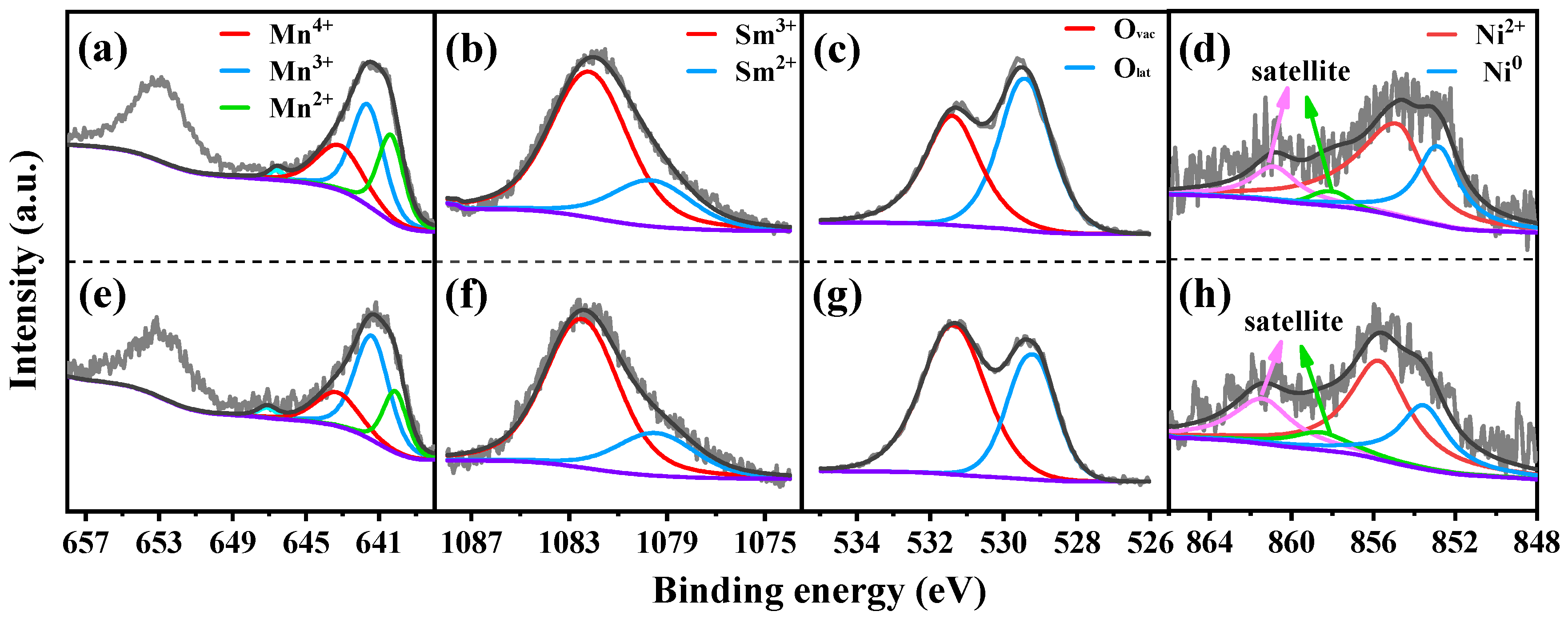
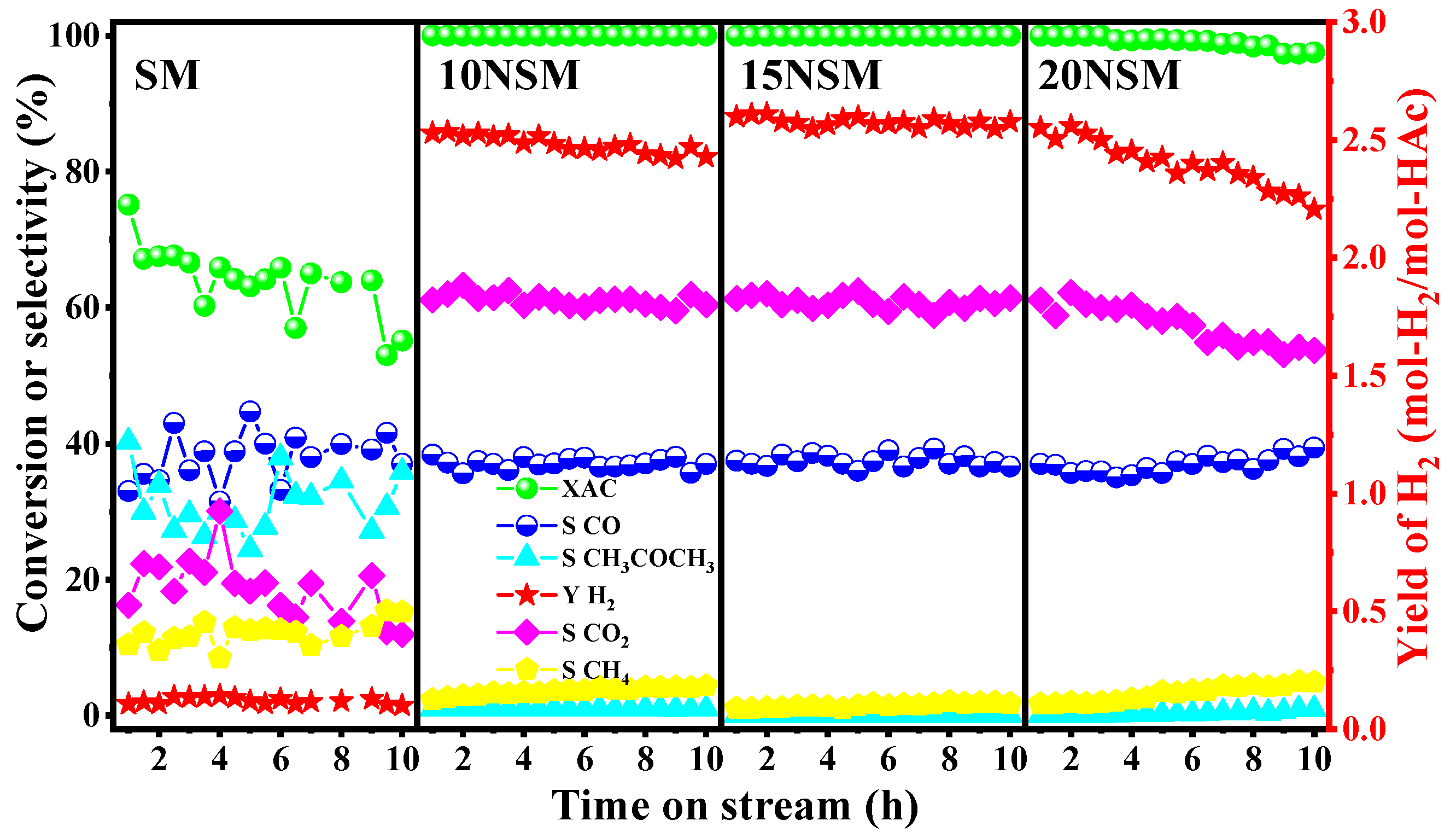

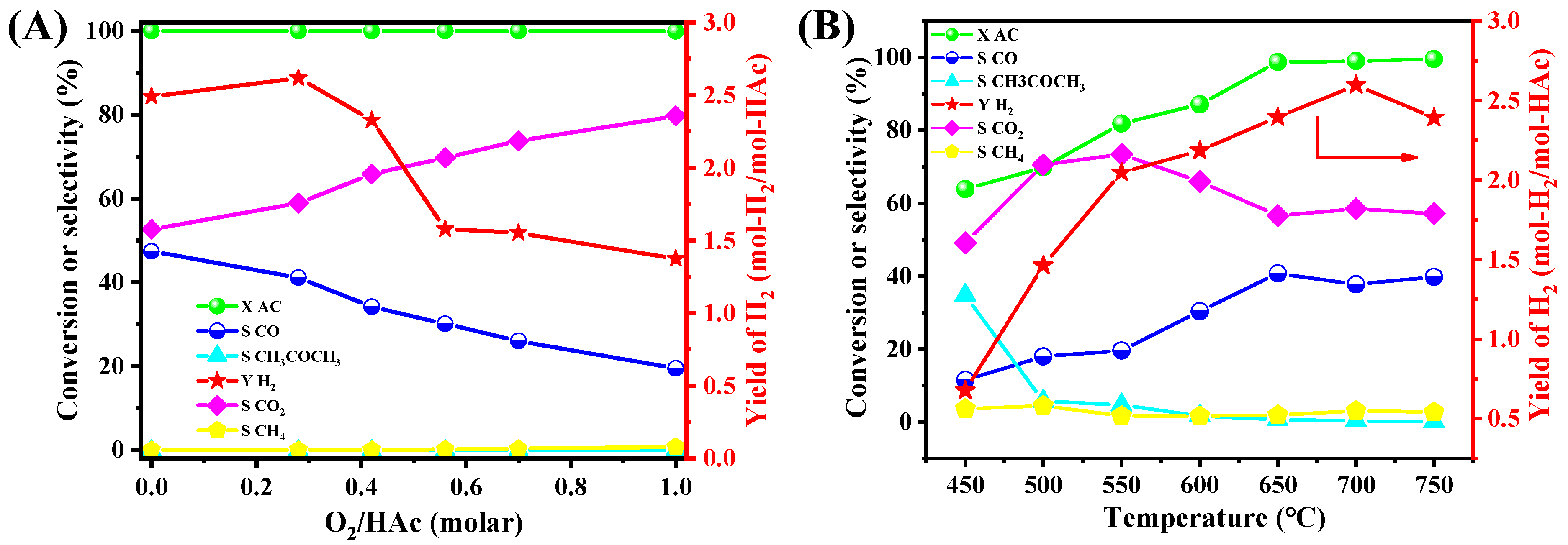
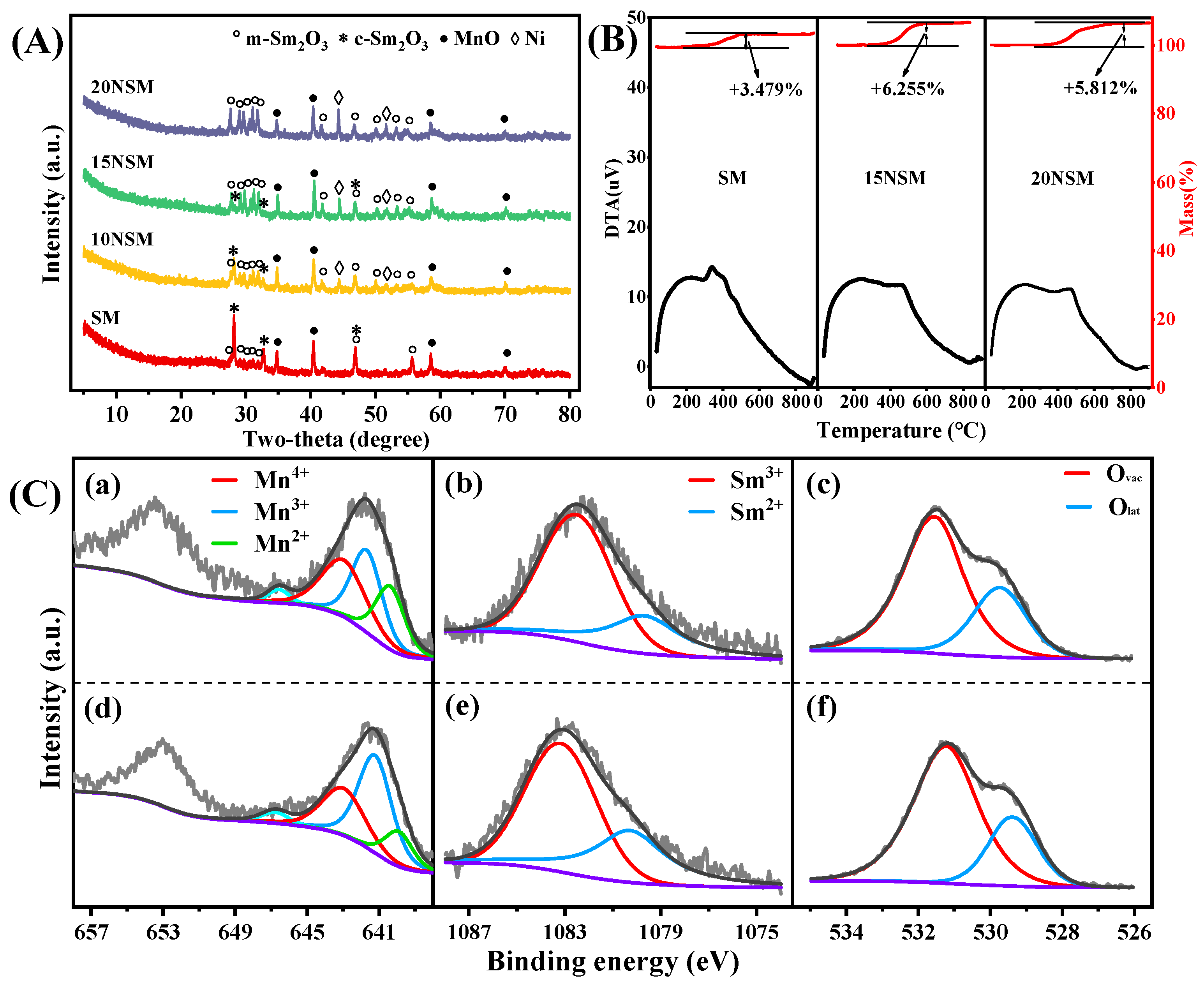
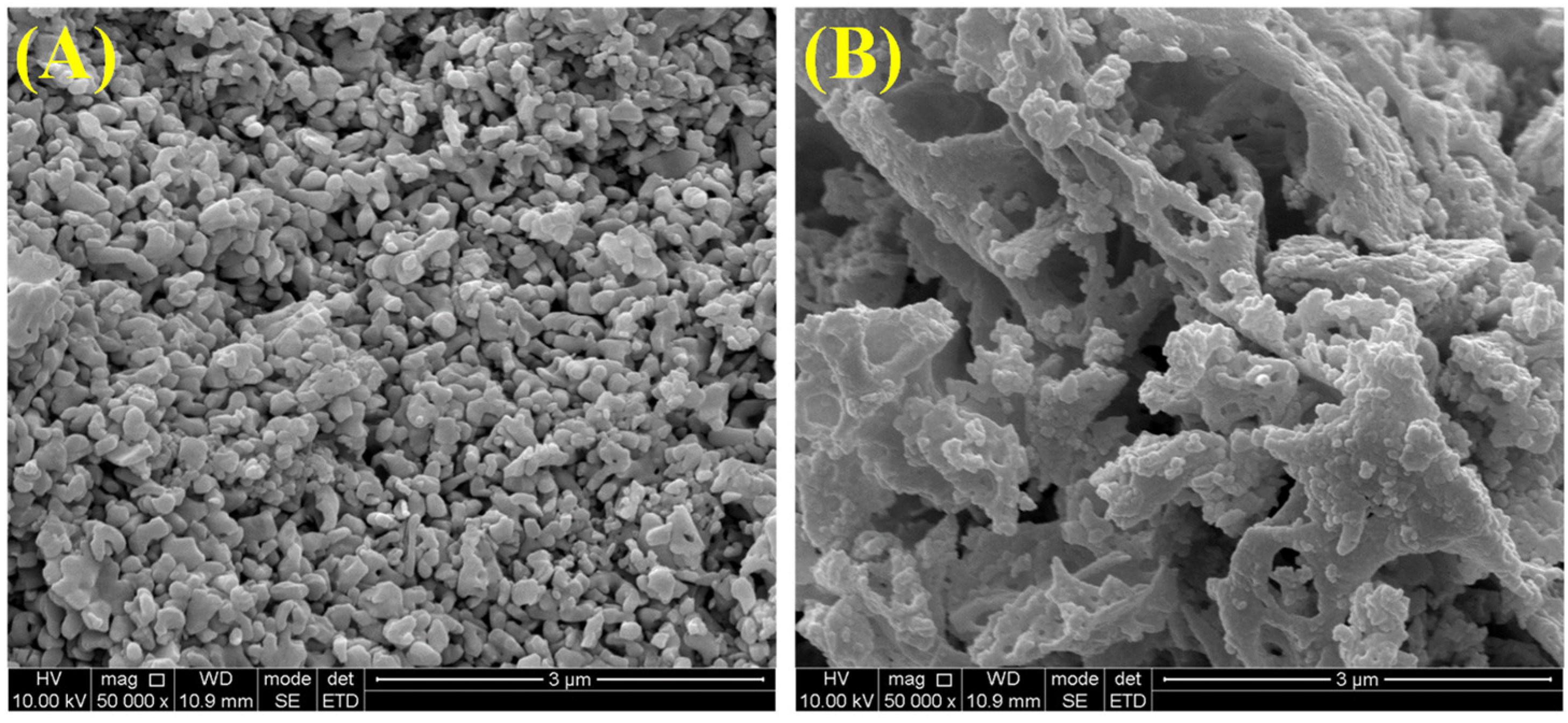
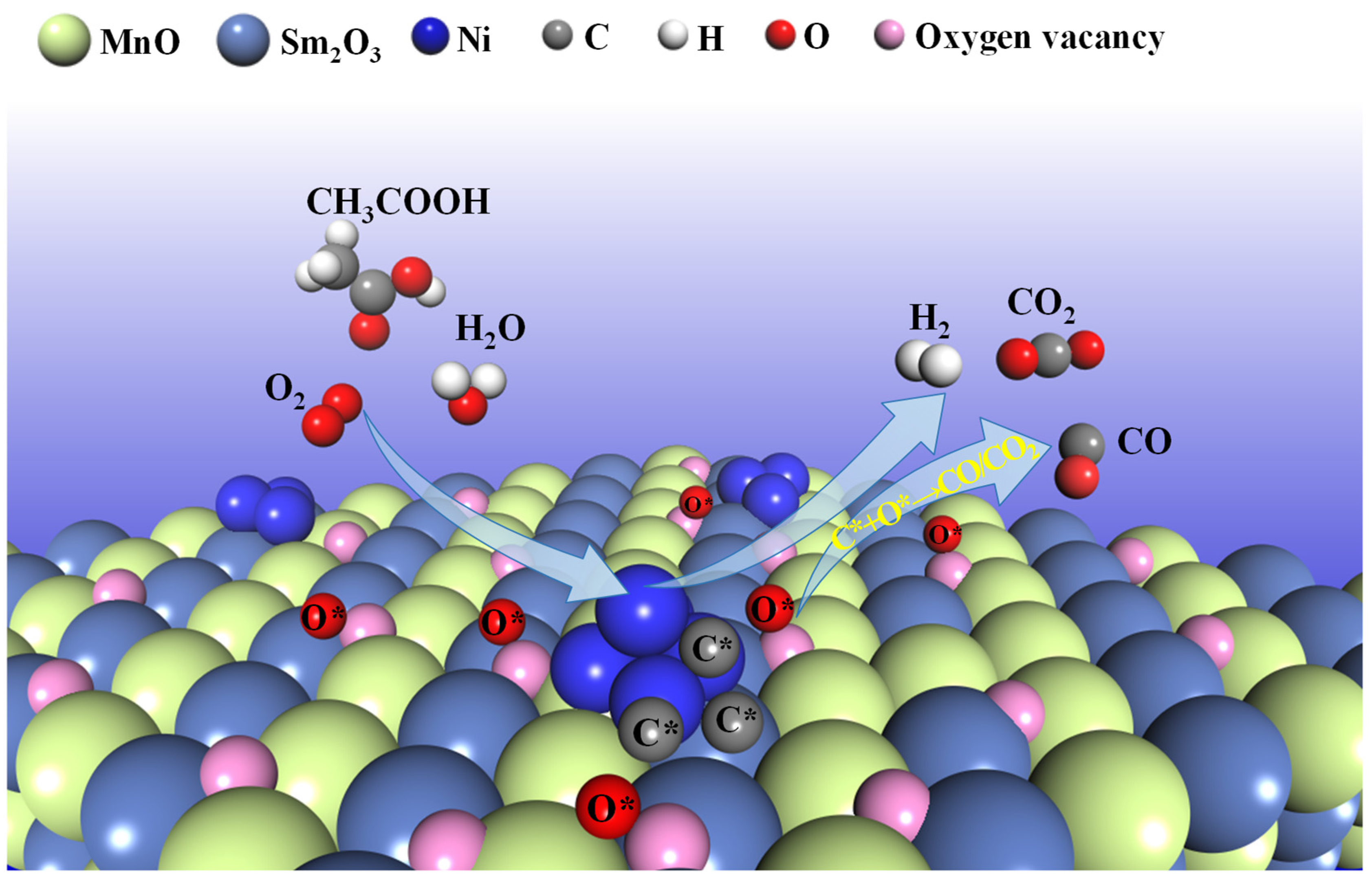
| Catalysts | Ni0 Particle Size Estimated by XRD (nm) | SSA (m2/g) | Pore Volume (cm3/g) | Average Pore Size (nm) | |
|---|---|---|---|---|---|
| Reduced a | Spent a | ||||
| SM | - | - | 8.0 | 0.020 | 2.9 |
| 10NSM | 31.4 | 36.5 | 11.8 | 0.108 | 2.7 |
| 15NSM | 41.6 | 42.9 | 15.1 | 0.048 | 2.6 |
| 20NSM | 50.4 | 53.2 | 7.3 | 0.029 | 2.4 |
| Samples | Mn3+/ (Mn2+ + Mn3+ + Mn4+) b | Sm2+/(Sm2+ + Sm3+) b | Ovac/(Olat + Ovac) b | Ni0/(Ni0 + Ni2+) b |
|---|---|---|---|---|
| SM | 43% | 35% | 42% | - |
| 15NSM | 55% | 40% | 64% | 32% |
| Catalysts | Ni0 Dispersion (%) | TOF (10−2·s−1) |
|---|---|---|
| 10NSM | 18.1 | 0.57 |
| 15NSM | 11.8 | 0.78 |
| 20NSM | 4.3 | 0.62 |
| Samples | Mn3+/ (Mn2+ + Mn3+ + Mn4+) | Sm2+/(Sm2+ +Sm3+) | Ovac/(Olat + Ovac) | Ni0/(Ni0 + Ni2+) |
|---|---|---|---|---|
| SM | 37% | 29% | 66% | - |
| 15NSM | 52% | 36% | 73% | 31% |
Disclaimer/Publisher’s Note: The statements, opinions and data contained in all publications are solely those of the individual author(s) and contributor(s) and not of MDPI and/or the editor(s). MDPI and/or the editor(s) disclaim responsibility for any injury to people or property resulting from any ideas, methods, instructions or products referred to in the content. |
© 2024 by the authors. Licensee MDPI, Basel, Switzerland. This article is an open access article distributed under the terms and conditions of the Creative Commons Attribution (CC BY) license (https://creativecommons.org/licenses/by/4.0/).
Share and Cite
Chen, H.; Chen, Q.; Hu, X.; Ding, C.; Huang, L.; Wang, N. Mullite-like SmMn2O5-Derived Composite Oxide-Supported Ni-Based Catalysts for Hydrogen Production by Auto-Thermal Reforming of Acetic Acid. Materials 2024, 17, 2490. https://doi.org/10.3390/ma17112490
Chen H, Chen Q, Hu X, Ding C, Huang L, Wang N. Mullite-like SmMn2O5-Derived Composite Oxide-Supported Ni-Based Catalysts for Hydrogen Production by Auto-Thermal Reforming of Acetic Acid. Materials. 2024; 17(11):2490. https://doi.org/10.3390/ma17112490
Chicago/Turabian StyleChen, Hui, Qi Chen, Xiaomin Hu, Chenyu Ding, Lihong Huang, and Ning Wang. 2024. "Mullite-like SmMn2O5-Derived Composite Oxide-Supported Ni-Based Catalysts for Hydrogen Production by Auto-Thermal Reforming of Acetic Acid" Materials 17, no. 11: 2490. https://doi.org/10.3390/ma17112490
APA StyleChen, H., Chen, Q., Hu, X., Ding, C., Huang, L., & Wang, N. (2024). Mullite-like SmMn2O5-Derived Composite Oxide-Supported Ni-Based Catalysts for Hydrogen Production by Auto-Thermal Reforming of Acetic Acid. Materials, 17(11), 2490. https://doi.org/10.3390/ma17112490






